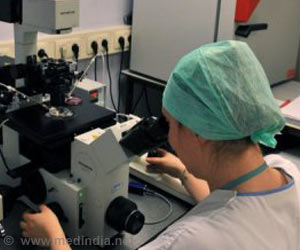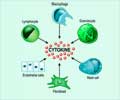Providing protection against disease without attacking healthy tissue, a properly functioning immune system is a lesson in balance.

The finding offers important insight into the immune response. The work also lays the foundation for advancing understanding and treatment of problems that arise when the system malfunctions, including autoimmune disorders that occur when the immune system targets healthy tissue or chronic infectious diseases and cancer where the immune response is insufficient.
T cells are the white blood cells that are the body's warriors, using a variety of weapons to combat cancer and viral infections. The receptors that extend above and below the cell membrane serve as a communication channel enabling the T cell response to match the threat. The researchers found that a component of the T cell receptor functions like a rheostat, helping to regulate a key aspect of that response – the sometimes explosive production of new T cells called proliferation.
"T cells are a double-edged sword, capable of launching a fierce attack to defeat an infection but also wreaking havoc if the response is too robust and results in damaging healthy tissue," said Dario Vignali, Ph.D., vice chair of the St. Jude Department of Immunology and the paper's senior author. "These findings suggest how T cell receptors help to manage the response and possibly guard against complications resulting from an overly aggressive response."
The results highlight the role of binding regions, called immunoreceptor tyrosine-based activation motifs (ITAMs), in orchestrating an appropriate T cell response. ITAMs are located on the receptor components that extend like tails below the surface of the cell membrane, connecting the T cell receptor to the cell's signaling pathways. Unlike other immune cell types whose receptors have just one or two ITAMs, T cell receptors have 10 ITAMs.
This study suggests that having so many ITAMs gives T cells greater flexibility in responding to threats. The research was published online February 3. Earlier work from Vignali's laboratory showed that mice whose T cells had as few as two working ITAMs could produce cytokines, molecules that combat infection by fueling inflammation. Those T cells, however, could not proliferate.
Advertisement
Previous research from the laboratory of Douglas Green, Ph.D., chair of the St. Jude Department of Immunology, showed c-Myc plays a key role in preparing T cells for rapid proliferation. Until this study, however, the steps involved in inducing c-Myc production were unknown.
Advertisement
The perceived strength of the T cell receptor signaling response also affected c-Myc expression in T cells but not cytokine secretion. T cells gauge their response in part by how strongly an antigen binds to the T cell receptor. Antigens are the pieces of the virus or other invader that alert T cells to a problem. A strong bond triggers higher levels of c-Myc and more proliferation. This study showed that T cells with fewer functional ITAMs produced less c-Myc than T cells with their full complement of 10 ITAMs regardless of the strength of the bond.
The findings reflect advances in imaging technology that allowed researchers to detect molecular interactions at the nanoscale level, said the paper's first author Clifford Guy, Ph.D., a postdoctoral fellow in Vignali's laboratory. A nanometer is one trillionth of a meter. The technology used in this study meant scientists could track how the number of functional ITAMs affected the ability of Vav1 and Notch1 to interact to within 30 to 50 nanometers, less than one-quarter the width of a human hair.
"This suggests that much like a rheostat controls the intensity of a lamp, ITAMs regulate how T cells respond to external threats, allowing them to scale the size of the response according to the size of the perceived threat," Guy said.
Source-Eurekalert












